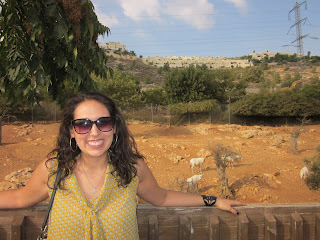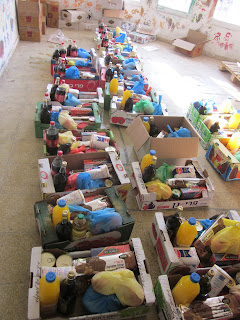The first post I wanted to share is about my experience on Real Life Israel's trip to the Negev back in November. Did you know that Israel is around half desert? Well it is, and that desert is called the Negev. We began our trip with a hike around an area called "Small Fin." See? it looks like a fin!
From the top we could see for miles - before I came to Israel I never thought that desert could be so beautiful.
After our hike we headed to some dunes where many of us rolled down over and over - I, coming from a windy, beachy area, am all too familiar with getting sand everywhere, and so decided to observe the fun instead:
Out on the dunes we made a fire and cooked up some Poiké - a stew made out of pretty much anything in a large iron pot. Satiated, we went on a night hike to search for desert critters - naturally I was very excited! I put on my trusty headlamp; the first thing we spotted was not an animal, but a Negev Lily - a flower that only blooms for 1-2 weeks a year. I felt truly special to have glimpsed it.
My desert hunt wouldn't be complete though without catching at least one critter - this is a Gecko that I just barely spotted - he had fantastic camouflage!
We stayed that night at a place called "Nitzana." Nitzana (ניצנה) is a communal village and youth education settlement that focuses mainly on water conservation. Before we got down to learning about what they do there (what I would consider the "fun part"), we had some free time at the pool. Naturally, I found a friend:
He didn't turn into a prince, but I saved him from the chlorine in the pool and released him into the moist bushes outside.
The next morning we got an in-depth tour of what they do at Nitzana and how they educate people about water conservation. We started in an outdoor classroom. Above the stage in Hebrew were the words "save every drop, because every drop counts." This is so much more a reality in Israel than in the United States. We may be educated in conservation as children but if we do not practice conservation we are unlikely to see consequences. In Israel, where there is so much desert and so little fresh water, conservation is essential. It's not a matter of making things easier or less expensive or better for the next generation. It is a matter of having enough fresh water for the country at large. For example, every toilet in Israel, no matter how old it is, has two handles. A small flush and a large flush. Why isn't this a standard in America? Because we don't have to make it one.
The demonstration in the outdoor classroom showed how much water an average person uses within two minutes when getting ready in the morning. It is much more than you think... We also played with a small model of a desalinization machine - something that is still very much in the experimental stage in America, but is a functioning reality in Israel. Why? Because they need it.
We were then led on a walking tour of the conservation demonstration area. Our first stop was a windmill that showed passive and active cooling techniques that are used on buildings in the desert.
The giant fan at the top (powered by solar energy) sends cool air down to those seated below. The black circles are pipes that shower down water for additional cooling when necessary.
The walls lower down were made of open cinder block, which keep the heat out, are cool, and allow ventilation. The motor beside Roni runs the fan and the hoses above.
Next we saw a variety of passive water collection techniques. Below is... a giant leaf? No, it's a dew collection board. Even in the desert, there is morning dew and this leaf can collect several inches a day. With a field full of these leaves, a great deal of fresh water can be collected without using any energy at all.
This is a giant bug zapper? No, it's a fog collector! The tiny metal mesh grabs low-traveling water molecules in fog or mist and funnels it down to a collection site. Yet another form of passive fresh water collection.
This pyramid, believe it or not, uses the sun to desalinate water. Salt water at the bottom of the pyramid evaporates when the warm desert sun hits it. Trapped by the glass, it condenses back into water and rolls down the sides of the pyramid into a collection trough. Smart, eh?
This is just a taste of all of the amazing breakthroughs from Israel in the field of Conservation. The question is, will they be applied worldwide, so that maybe we can stop depleting resources until we have to use all of these methods just to get the bare minimum of what we need?
The people living at Nitzana, as well as their many students, all take part in education, and applied conservation. They are aware of the imminent threat to our planet and the necessity to change the way we use up what mother nature has given to us. When will the people who push a button and get water, or push a button and get electricity, or push a button and get heat, realize that there is something happening on the other side of that wall that is hurting our planet, and that it is only a matter of time before we push that button and nothing happens? Will we realize before it's too late?
I hope and believe it is possible. This is why I have devoted my life to conservation and education. I, like the teachers at Nitzana, believe that if our planet's children are taught about these problems and their potential solutions early on, that they will proceed in their lives a bit differently, and make change happen.
This trip was a lot of fun, but it was much more than that for me. It has opened my eyes to a new tactic in conservation education. Perhaps a feeling of necessity is beneficial to making effective change - maybe my new job is not only to educate children about conservation, but to also educate them in it's necessity. You may think that change isn't immediately important, especially in the United States, but I believe it is.
That idea brings me back to the title of this post - It's easier to conserve when it's required. I think it's time to make it required - EVERYWHERE. What do you say?





















































